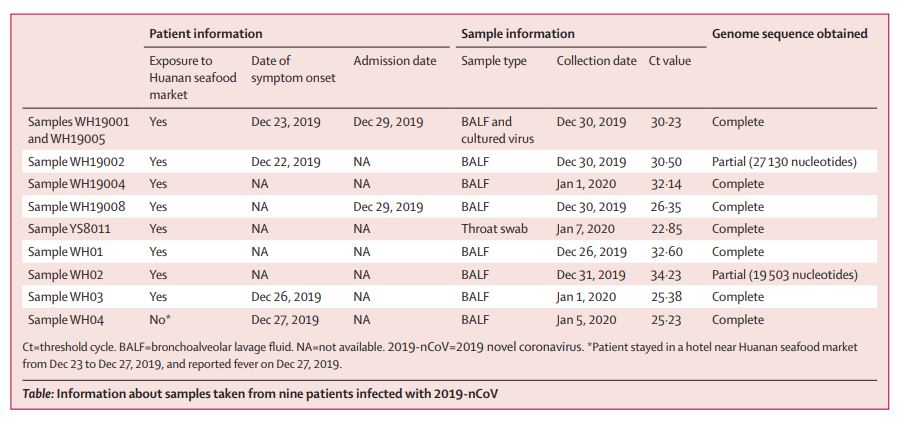The authors say that although their analysis suggests that bats might be the original host of the virus, an animal sold at the Huanan seafood market in Wuhan might represent an intermediate host that enables the emergence of the virus in humans.
In the study, the authors report the epidemiological data of nine patients who were diagnosed with viral pneumonia of unidentified cause. Cell and secretion samples were taken from the patients’ lungs to harvest samples of the 2019-nCoV virus, which were analyzed to determine the origin of the virus and how it enters human cells.
Eight of the patients had visited the Huanan seafood market. One patient had never visited the market, but had stayed in a hotel near the market before the onset of their illness.

The authors found 2019-nCoV in all 10 genetic samples taken from the patients – including eight complete genomes, and two partial genomes. The genetic sequences of the samples were nearly identical (shared more than 99.98% of the same genetic sequence) – which indicates a very recent emergence of the virus into humans.
“It is striking that the sequences of 2019-nCoV described here from different patients were almost identical. This finding suggests that 2019-nCoV originated from one source within a very short period and was detected relatively rapidly. However, as the virus transmits to more individuals, constant surveillance of mutations arising is needed,” says one of lead authors Professor Weifeng Shi, Key Laboratory of Etiology and Epidemiology of Emerging Infectious Diseases in Universities of Shandong, Shandong First Medical University and Shandong Academy of Medical Sciences, China.
Comparing the 2019-nCoV genetic sequence with a library of viruses, the authors found that the most closely related viruses were two SARS-like coronaviruses of bat origin – bat-SL-CoVZC45 and bat-SL-CoVZXC21 – which shared 88% of the genetic sequence. 2019-nCoV was more genetically distant to the human SARS virus (which shared about 79% of the genetic sequence) and the Middle East respiratory syndrome (MERS) virus (which shared about 50% of the genetic sequence).
Studying the spike protein of the virus (how it binds then enters human cells), the authors found that 2019-nCoV and human SARS virus have similar structures, despite some small differences. As a result, the authors suggest that 2019-nCoV might use the same molecular doorway to enter the cells as SARS (a receptor called ACE2), but note that this will require confirmation.
Based on their data, the authors say that it seems likely that the 2019-nCoV causing the Wuhan outbreak might also be initially hosted by bats and transmitted to humans via a currently unknown wild animal sold at the Huanan seafood market.
They say that it is more likely that bat coronaviruses are mutating, than 2019-nCoV – meaning that 2019-nCoV is unlikely to have emerged due to a chance mutation. However, more information is needed, and if a more closely related animal virus is identified, this suggestion could be wrong.
“These data are consistent with a bat reservoir for coronaviruses in general and 2019-nCoV in particular. However, despite the importance of bats, it seems likely that another animal host is acting as an intermediate host between bats and humans,” says Professor Guizhen Wu, Chinese Center for Disease Control and Prevention.
Explaining this she notes: “First, the outbreak was first reported in late December, 2019, when most bat species in Wuhan are hibernating. Second, no bats were sold or found at the Huanan seafood market, whereas many non-aquatic animals (including mammals) were. Third, the similarities in the genetic sequences between 2019-nCoV and its close relatives bat-SL-CoVZC45 and bat-SL-CoVZXC21 were less than 90%, meaningthese two bat-derived coronaviruses are not direct ancestors of 2019-nCoV. Fourth, in both SARS and MERS, bats acted as the natural reservoir, with another animal acting as an intermediate host, and with humans as terminal hosts.This again highlights the hidden virus reservoir in wild animals and their potential to spill over into human populations.”





Comments